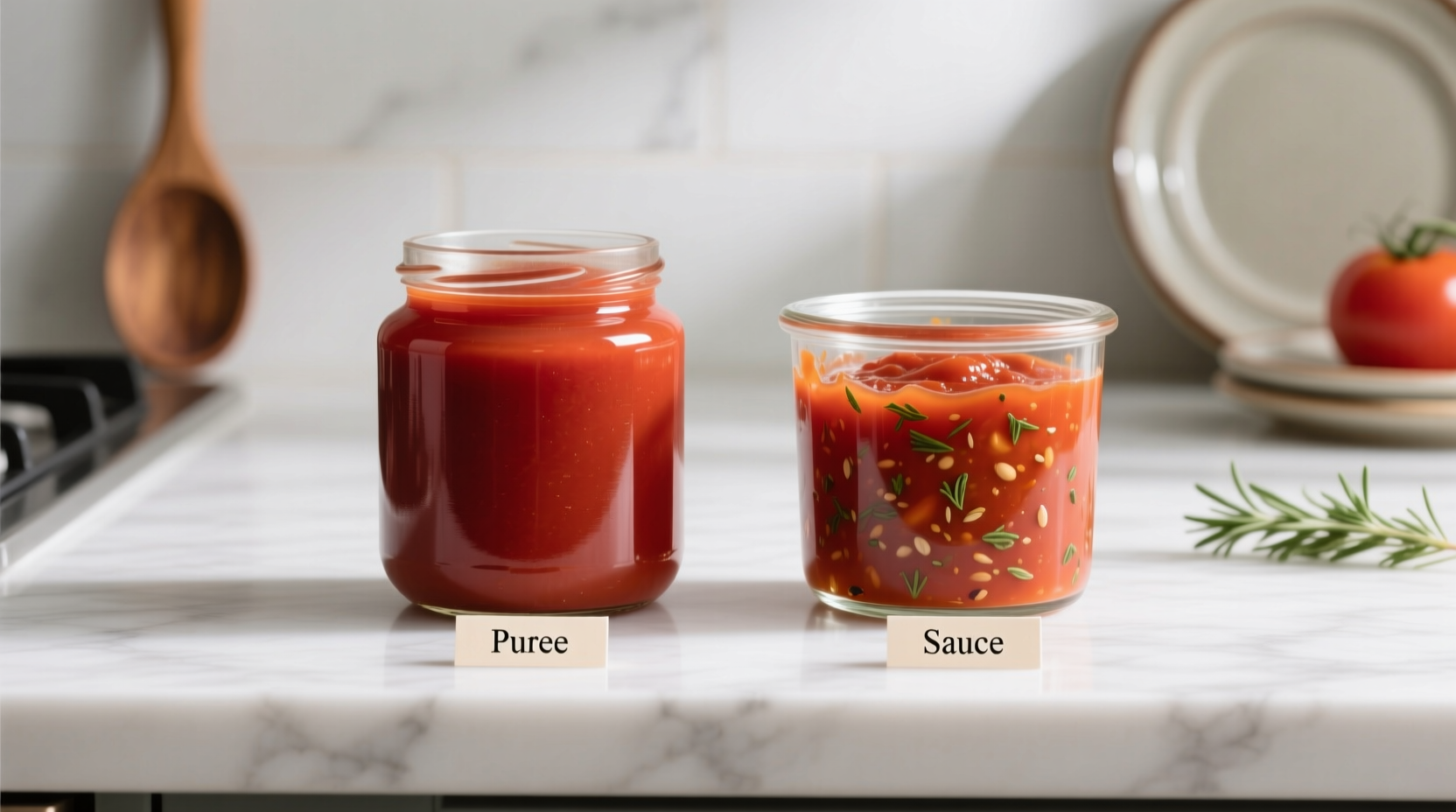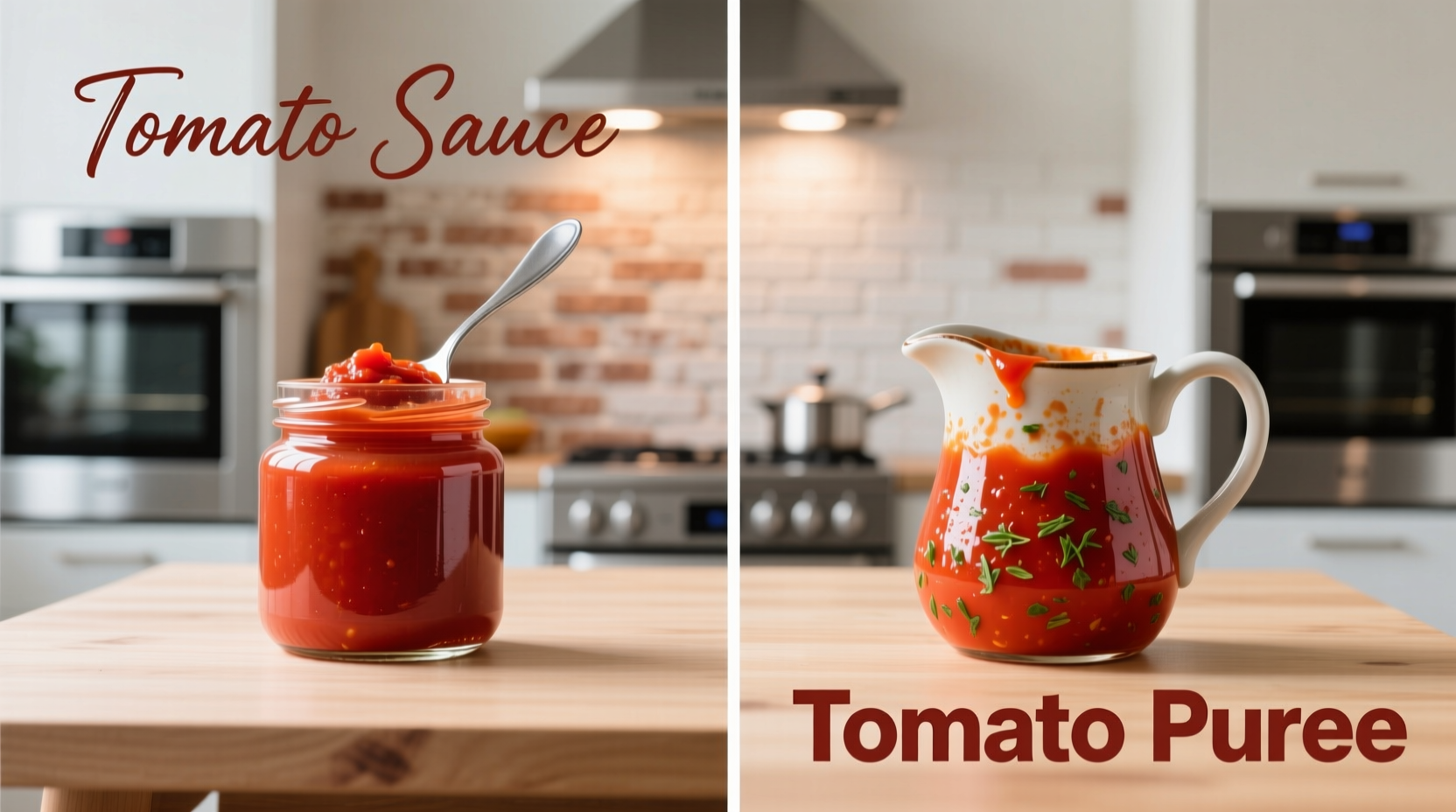Tomato puree is a thick, smooth concentrate made from cooked and strained tomatoes with no added ingredients, while tomato sauce includes additional seasonings like herbs, garlic, and onions. Puree has a more intense tomato flavor and thicker consistency, making it ideal as a base for sauces you'll season yourself. Sauce is ready-to-use with built-in flavors, perfect for quick pasta dishes or as a pizza base.
Confused about whether to reach for tomato puree or tomato sauce in your pantry? You're not alone. Many home cooks mistakenly use these tomato products interchangeably, only to find their dishes lacking proper texture or flavor balance. Understanding the critical differences between tomato puree vs tomato sauce transforms your cooking results dramatically. This guide delivers exactly what you need: clear differentiation points, practical substitution advice, and professional chef insights to help you choose the right product for every recipe.
Understanding the Core Differences
At first glance, tomato puree and tomato sauce appear similar in the grocery aisle, but their composition and culinary purposes differ significantly. Tomato puree represents the essence of tomatoes—simply cooked, strained tomatoes with nothing added. It's essentially concentrated tomato flavor in its most basic form. Tomato sauce, by contrast, begins with tomato puree or crushed tomatoes but then incorporates additional ingredients like onions, garlic, herbs, and sometimes sugar or citric acid for preservation.
| Characteristic | Tomato Puree | Tomato Sauce |
|---|---|---|
| Ingredients | 100% tomatoes | Tomatoes plus seasonings, sometimes thickeners |
| Texture | Thick, smooth, paste-like | Thinner, more liquid consistency |
| Flavor Profile | Intense tomato flavor, slightly acidic | Balanced with herbs, garlic, onions, sometimes sweet |
| Typical Use | Base for sauces you'll season yourself | Ready-to-use in recipes requiring minimal additional seasoning |
| Nutrition (per 100g) | 42 calories, 0.5g protein, 9.1g carbs (USDA FoodData Central) | 39 calories, 1.3g protein, 8.3g carbs (USDA FoodData Central) |
When to Use Each Product: Practical Applications
Professional chefs consistently select between tomato puree and sauce based on the specific requirements of their recipe. Understanding these context boundaries prevents common cooking mistakes that ruin otherwise promising dishes.
Choose Tomato Puree When:
- You're creating a custom sauce from scratch and want complete control over seasoning
- Thickening soups, stews, or braises without adding extra flavors
- Need a concentrated tomato flavor that won't water down your dish
- Preparing dishes where additional seasonings might clash with your flavor profile
Choose Tomato Sauce When:
- You need a quick base for pasta dishes with minimal additional ingredients
- Creating pizza with a ready-made flavorful base
- Time-constrained cooking where building complex flavors isn't feasible
- Recipes specifically call for "tomato sauce" rather than "tomato puree"
Historical Evolution of Tomato Products
The development of modern tomato processing reflects changing culinary needs. According to the National Center for Home Food Preservation, commercial tomato puree emerged in the early 20th century as food manufacturers sought ways to preserve summer tomatoes. The USDA first standardized tomato puree specifications in 1938, defining it as "the semifluid product obtained by sieving cooked tomatoes to remove skins and seeds."
Tomato sauce evolved later as convenience foods gained popularity. Food historians note that pre-seasoned tomato sauces became mainstream in American kitchens during the 1950s post-war era, when time-saving products were highly valued. The addition of herbs and seasonings transformed basic tomato puree into a ready-to-use product that aligned with changing lifestyle patterns.

Substitution Guidance: Making the Switch Without Ruining Your Dish
Running out of one product doesn't mean your recipe is doomed. Smart substitutions maintain dish integrity when executed properly:
Using Puree as Sauce Substitute
Dilute ½ cup tomato puree with ¼ cup water and add ½ teaspoon dried basil, ¼ teaspoon garlic powder, and a pinch of salt. This creates an approximation of basic tomato sauce. Remember that commercial sauces often contain sugar, so taste before adding sweeteners.
Using Sauce as Puree Substitute
Simmer tomato sauce uncovered for 15-20 minutes to reduce liquid content. For every cup of sauce, expect to lose about ¼ cup of liquid through evaporation. This concentrates the tomato flavor while maintaining the added seasonings.
Professional chefs at the Culinary Institute of America recommend always tasting your substitution before incorporating it into your main dish. Adjust seasoning as needed since commercial products vary significantly between brands.
Avoiding Common Tomato Product Mistakes
Even experienced cooks make these frequent errors with tomato products:
- Mistake: Using tomato sauce when a recipe calls for puree without adjusting other seasonings
Solution: Reduce or eliminate additional herbs and garlic in your recipe - Mistake: Assuming all "tomato sauce" products are identical
Solution: Read ingredient labels—some contain added sugar, citric acid, or preservatives that affect flavor - Mistake: Not adjusting cooking times when substituting products
Solution: Puree requires longer cooking to mellow acidity, while sauce may need less time to prevent over-reduction
Creating Homemade Versions for Superior Flavor
For the freshest results, consider making your own tomato puree or sauce. The process is surprisingly simple and yields noticeably better flavor than commercial products.
Homemade Tomato Puree: Blanch ripe tomatoes in boiling water for 30 seconds, then transfer to ice water. Peel, remove cores, and simmer until soft. Blend until smooth, then push through a fine-mesh sieve to remove seeds and skins. Simmer the strained liquid until it reaches your desired thickness.
Homemade Tomato Sauce: Start with your homemade puree, then sauté onions and garlic in olive oil until translucent. Add the puree along with fresh basil, oregano, salt, and a pinch of red pepper flakes. Simmer for 30-45 minutes to develop flavors.
According to research published in the Journal of Food Science, homemade tomato products retain up to 30% more lycopene—the beneficial antioxidant in tomatoes—compared to commercially processed versions, as excessive heat during commercial canning degrades some nutrients.
Frequently Asked Questions
Here are answers to the most common questions about tomato puree vs tomato sauce:











 浙公网安备
33010002000092号
浙公网安备
33010002000092号 浙B2-20120091-4
浙B2-20120091-4